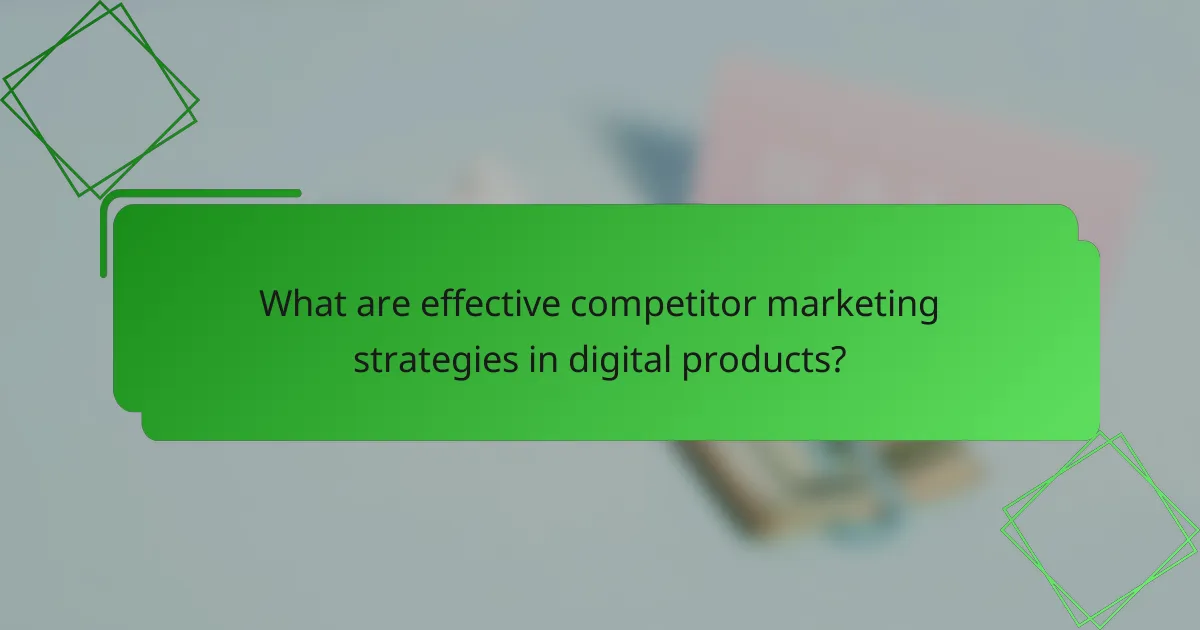In the competitive landscape of digital products, understanding and analyzing competitor marketing strategies is crucial for achieving visibility and customer loyalty. By examining rivals’ strengths, weaknesses, and unique value propositions, businesses can differentiate themselves and enhance their own marketing efforts. Effective tactics such as content marketing, social media advertising, and SEO optimization play a vital role in this process, ultimately driving sustainable growth and engagement.

What are effective competitor marketing strategies in digital products?
Effective competitor marketing strategies in digital products focus on understanding and leveraging the strengths and weaknesses of rivals to enhance visibility, engagement, and customer retention. These strategies often include content marketing, social media advertising, email campaigns, and SEO optimization.
Content marketing for engagement
Content marketing is vital for engaging potential customers by providing valuable, relevant information that addresses their needs. This can include blog posts, videos, infographics, and podcasts that resonate with your target audience.
To implement effective content marketing, create a content calendar that aligns with your audience’s interests and industry trends. Regularly update your content to keep it fresh and relevant, and consider using storytelling techniques to make your message more relatable.
Social media advertising for reach
Social media advertising allows businesses to reach a broader audience by targeting specific demographics and interests. Platforms like Facebook, Instagram, and LinkedIn offer robust tools for creating tailored ads that can drive traffic and conversions.
When using social media ads, set clear objectives, such as brand awareness or lead generation, and monitor performance metrics to optimize your campaigns. Experiment with different ad formats, such as carousel ads or video ads, to see what resonates best with your audience.
Email campaigns for retention
Email campaigns are essential for retaining customers by keeping them informed and engaged with your brand. Regular newsletters, promotional offers, and personalized content can help maintain customer interest and loyalty.
To maximize the effectiveness of email campaigns, segment your audience based on their behavior and preferences. Use compelling subject lines and clear calls to action to encourage opens and clicks, and regularly analyze your email performance to refine your strategy.
SEO optimization for visibility
SEO optimization is crucial for enhancing the visibility of your digital products in search engine results. By optimizing your website and content for relevant keywords, you can attract organic traffic and improve your rankings.
Focus on both on-page and off-page SEO techniques, such as optimizing meta tags, improving site speed, and building quality backlinks. Regularly conduct keyword research to stay updated on trends and adjust your content strategy accordingly to maintain a competitive edge.

How can I analyze competitor marketing strategies?
To analyze competitor marketing strategies, start by gathering data on their tactics, target audience, and performance metrics. This involves examining their strengths, weaknesses, market positioning, and how they measure success against industry standards.
SWOT analysis for strengths and weaknesses
A SWOT analysis helps identify the strengths and weaknesses of competitors, along with opportunities and threats in the market. Focus on their unique selling propositions, brand reputation, and customer loyalty as strengths, while noting areas where they may lack, such as product quality or customer service.
For example, if a competitor excels in digital marketing but struggles with customer retention, this insight can guide your own strategy. Use this analysis to highlight your advantages and address any weaknesses in your offerings.
Market share analysis for positioning
Market share analysis provides insight into how competitors position themselves within the industry. By assessing their share of the market, you can determine their influence and target audience demographics.
For instance, if a competitor holds a significant market share in a specific region, consider their marketing tactics and customer engagement strategies. This can inform your own positioning and help you identify gaps in the market that you can exploit.
Benchmarking against key performance indicators
Benchmarking involves comparing your competitors’ performance against key performance indicators (KPIs) such as sales growth, customer acquisition costs, and return on investment. This process allows you to gauge where you stand relative to your competitors.
To effectively benchmark, collect data from industry reports or competitor websites. Look for trends in their marketing effectiveness and adjust your strategies accordingly. For example, if a competitor achieves high conversion rates through targeted ads, consider adopting similar tactics to enhance your own performance.

What differentiates successful competitors in the digital product space?
Successful competitors in the digital product space stand out through their unique value propositions, exceptional customer experiences, and innovative pricing models. These elements not only attract customers but also foster loyalty and drive sustainable growth.
Unique value propositions
A unique value proposition (UVP) clearly communicates what makes a product distinct and why customers should choose it over alternatives. Successful companies often highlight specific features, benefits, or solutions that address customer pain points effectively.
For instance, a software tool that automates a tedious task can emphasize time savings and increased productivity as its UVP. Competitors should regularly assess their offerings to ensure their UVP resonates with target audiences and remains relevant in a dynamic market.
Customer experience enhancements
Enhancing customer experience involves creating seamless interactions at every touchpoint, from initial contact to post-purchase support. Companies that prioritize user-friendly interfaces, responsive customer service, and personalized communications tend to retain customers more effectively.
For example, a digital platform that offers live chat support and tailored recommendations based on user behavior can significantly improve satisfaction. Regularly gathering customer feedback and making iterative improvements can help maintain a competitive edge in customer experience.
Innovative pricing models
Innovative pricing models can differentiate competitors by aligning costs with customer value perception. Subscription-based pricing, tiered plans, or pay-per-use options allow flexibility and can cater to various customer segments.
For instance, a SaaS product might offer a free tier with limited features, encouraging users to upgrade as their needs grow. Companies should analyze market trends and customer preferences to determine the most effective pricing strategies that enhance perceived value while ensuring profitability.

What tools can assist in competitor analysis?
Several tools can effectively assist in competitor analysis by providing insights into SEO performance, backlink profiles, and content engagement. Utilizing these tools can help businesses identify strengths and weaknesses in their marketing strategies compared to competitors.
SEMrush for SEO insights
SEMrush is a comprehensive tool that offers valuable SEO insights by analyzing competitors’ keyword strategies, organic search positions, and traffic sources. Users can track specific keywords, assess their ranking changes, and discover new opportunities for optimization.
To get started, input your competitor’s domain into SEMrush to view their top-performing keywords and estimated traffic. This can help you identify gaps in your own strategy and areas for improvement.
Ahrefs for backlink analysis
Ahrefs specializes in backlink analysis, allowing users to explore the link profiles of competitors. This tool provides information on the number of backlinks, referring domains, and the quality of those links, which can be crucial for improving your own link-building efforts.
When using Ahrefs, focus on identifying high-authority sites linking to your competitors. Aim to replicate similar backlinks to enhance your domain authority and search engine rankings.
BuzzSumo for content performance
BuzzSumo is designed to analyze content performance across various platforms, helping you understand what resonates with audiences. It allows users to see which articles or posts have gained the most shares and engagement, providing insights into effective content strategies.
To leverage BuzzSumo, search for topics relevant to your industry and review the top-performing content. This can inform your content creation efforts and help you develop unique angles that stand out in the market.

What are the key metrics for evaluating competitor strategies?
Key metrics for evaluating competitor marketing strategies include conversion rates, customer acquisition costs, and engagement rates. These metrics provide insights into how effectively a competitor attracts and retains customers, enabling businesses to identify strengths and weaknesses in their own strategies.
Conversion rates for effectiveness
Conversion rates measure the percentage of users who take a desired action, such as making a purchase or signing up for a newsletter. A high conversion rate indicates that a competitor’s marketing strategies effectively persuade potential customers. Typical conversion rates can vary widely, but many industries see rates between 1% and 5% as average benchmarks.
To evaluate conversion rates, consider the specific actions that define success for your business and compare them against competitors. Tools like Google Analytics can help track these metrics, allowing for a clearer understanding of what drives conversions in your market.
Customer acquisition costs for efficiency
Customer acquisition cost (CAC) refers to the total cost of acquiring a new customer, including marketing expenses, sales team costs, and any promotional offers. Understanding CAC is crucial for assessing the efficiency of a competitor’s marketing efforts. A lower CAC can indicate a more effective strategy, while a higher CAC may suggest inefficiencies or higher spending on customer outreach.
When analyzing CAC, consider factors such as industry averages and the lifetime value of a customer (LTV). A common rule of thumb is that CAC should be no more than one-third of LTV to ensure profitability. Regularly reviewing these costs can help identify areas for improvement in your own customer acquisition strategies.
Engagement rates for audience interaction
Engagement rates measure how actively users interact with a brand’s content, including likes, shares, comments, and overall participation. High engagement rates often correlate with a strong brand presence and customer loyalty. Engagement can vary significantly by platform, with social media typically showing rates from 1% to 10% depending on the industry and content type.
To assess engagement rates, analyze metrics across various channels, such as social media platforms, email campaigns, and website interactions. Tools like Hootsuite or Buffer can provide insights into how well competitors engage their audience, helping you refine your own content strategies for better interaction.

How can I implement insights from competitor analysis?
Implementing insights from competitor analysis involves identifying effective strategies used by competitors and adapting them to your own business model. This process can enhance your marketing efforts, improve customer engagement, and ultimately drive sales.
Adopt best practices from competitors
To adopt best practices from competitors, start by analyzing their successful marketing strategies, customer engagement techniques, and product offerings. Look for patterns in their messaging, promotional channels, and customer feedback that resonate well with their audience.
Consider creating a comparative table to highlight key practices. For example, if a competitor excels in social media engagement, note their posting frequency, types of content, and audience interaction. This can help you identify actionable strategies to implement in your own marketing efforts.
Be mindful of the differences in your target audience. While adopting practices, ensure they align with your brand identity and customer preferences. Avoid copying directly; instead, adapt and innovate based on what works for your competitors while maintaining your unique voice.


